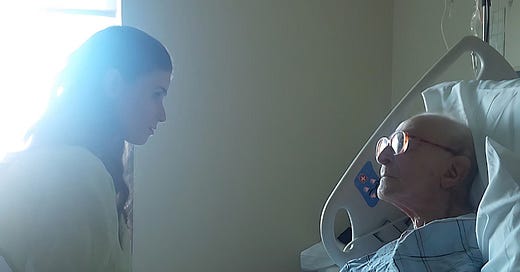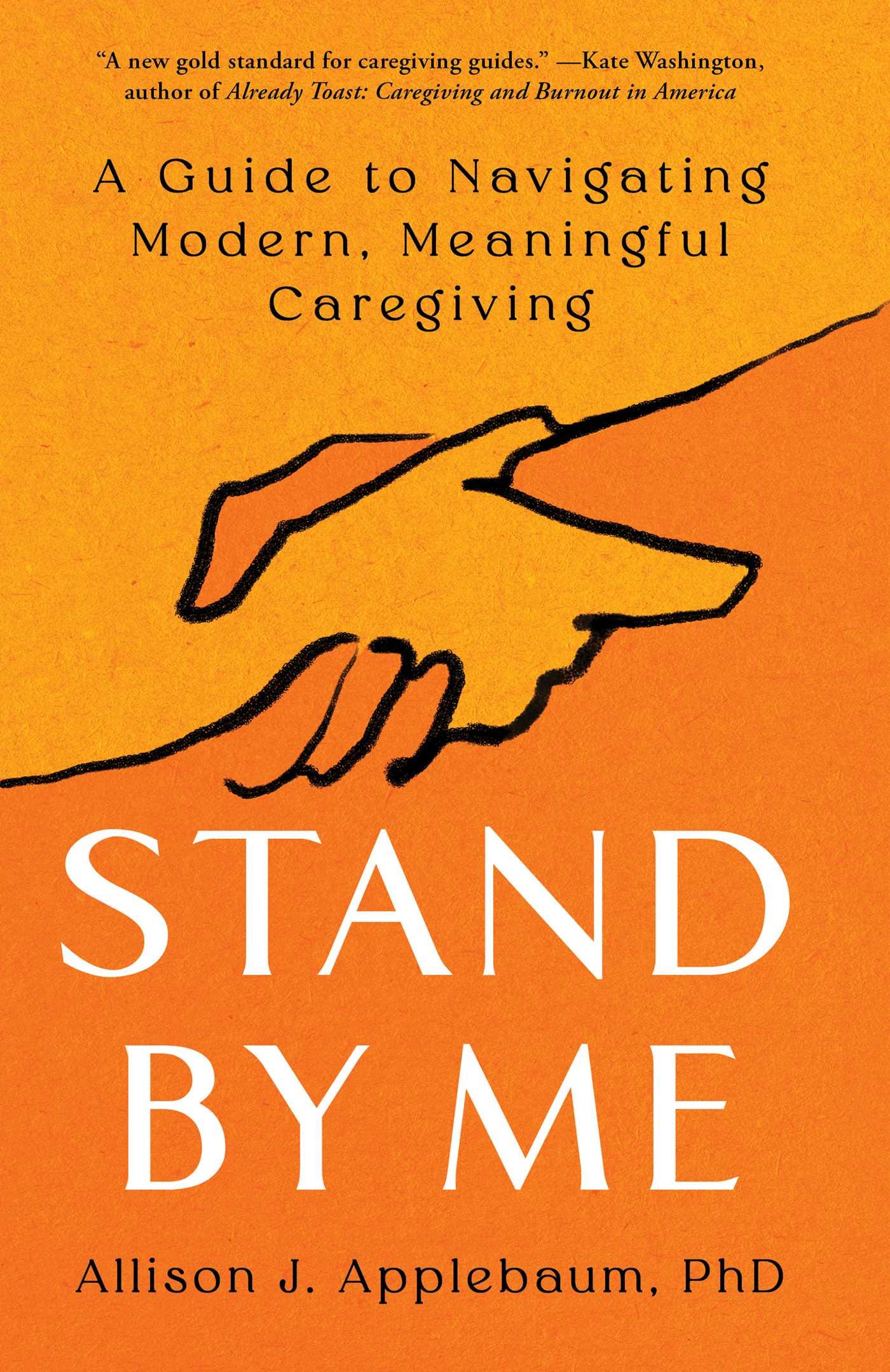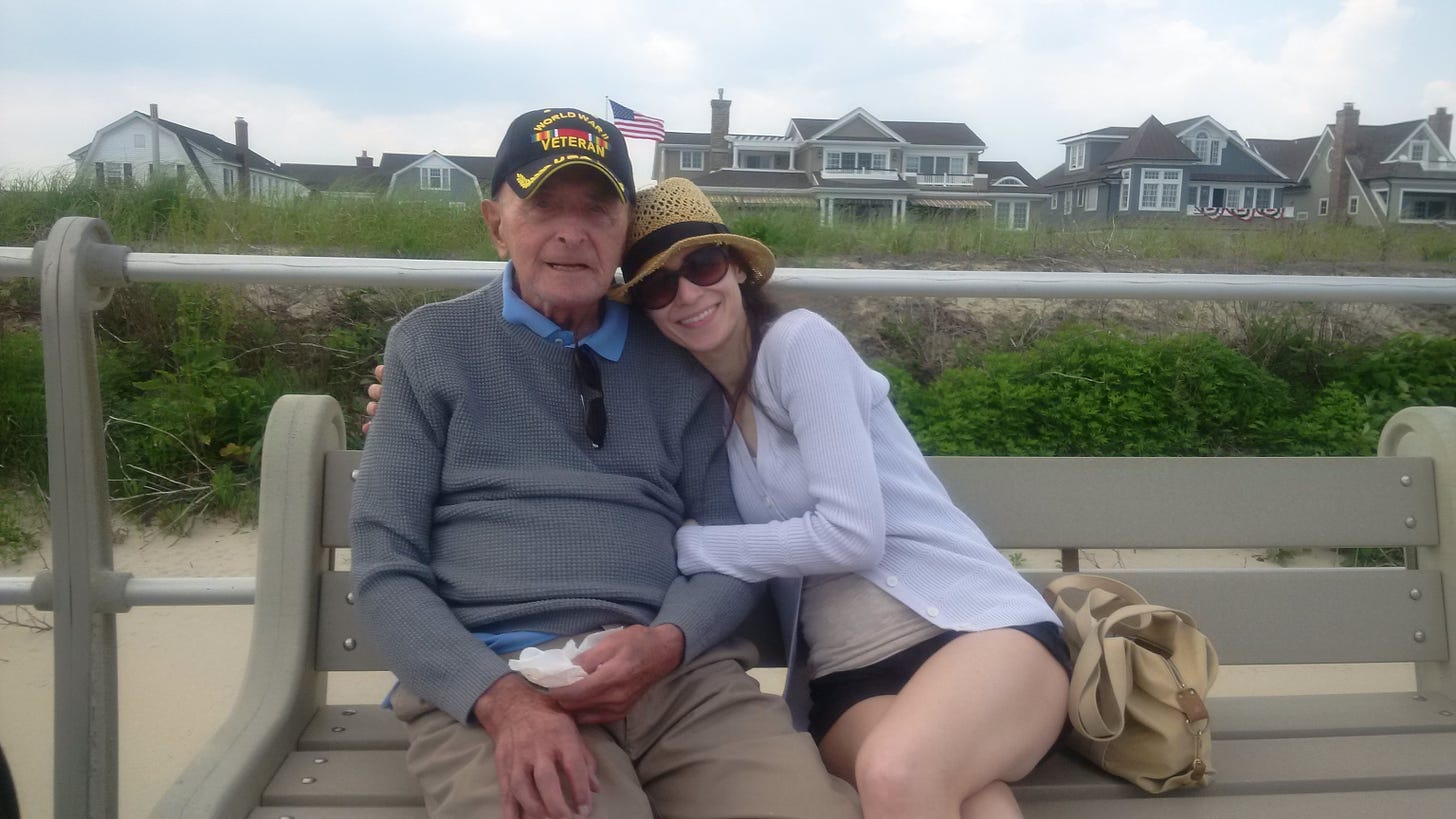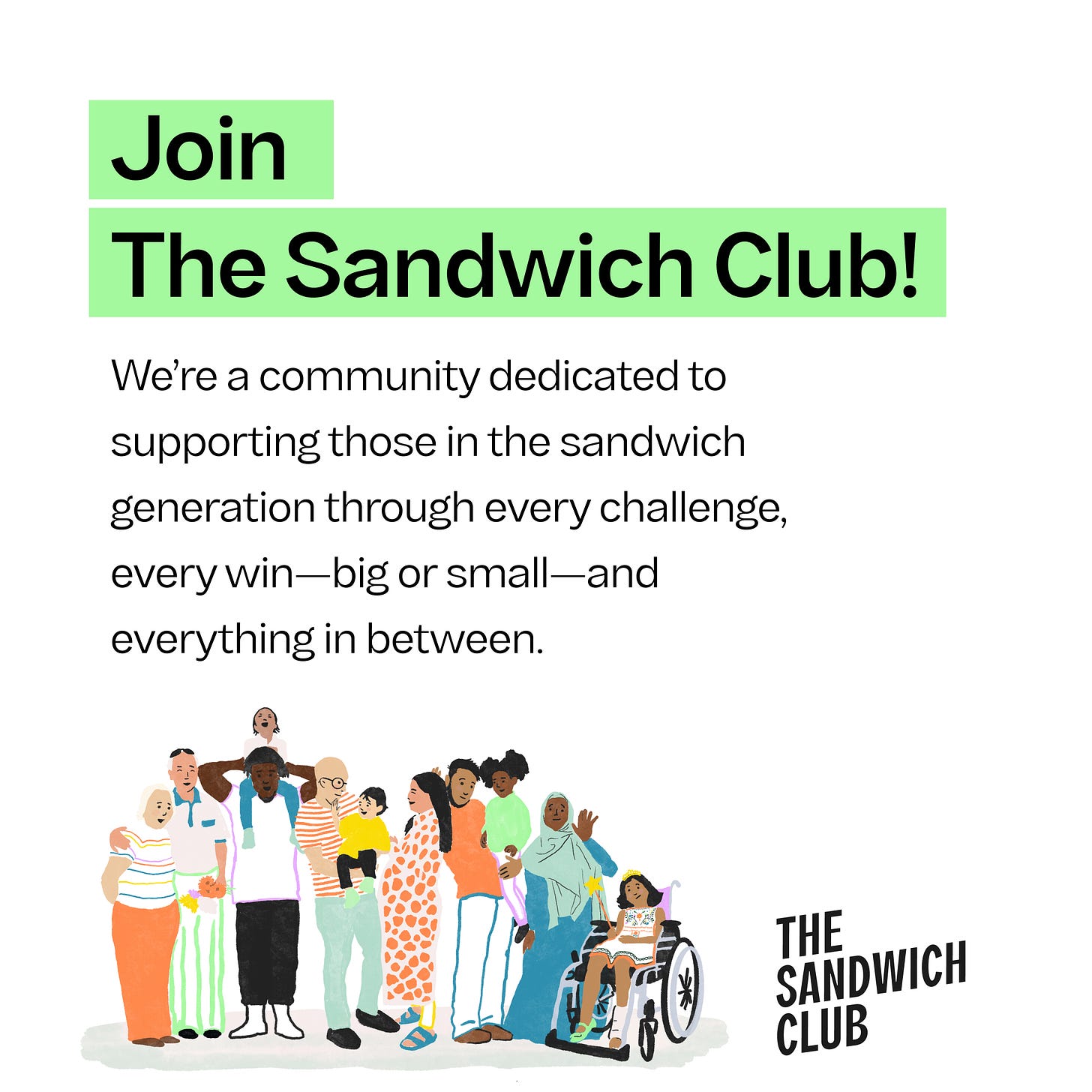Caregiving as a perilous portal to meaning
5 questions for clinical psychologist and family care expert Allison Applebaum
How do we resist resentment while caregiving? How do we honor our loved ones wishes as they change so profoundly? How do we ask for and afford help? How do we deal with the transitions between caring for elders and caring for kids? How do we honor our grief amid so many logistics?
These are just a few of the questions that I’m, personally, navigating right now as a sandwich generation caregiver. But I’m not alone. There are 54 millions of us out there!
My brother is one of them—we are a team these days, juggling our four kids, our dad, who has fairly advanced dementia, and our work in the world. It is, to put it mildly, complicated. So many logistics and emotions. Never enough time. Always enough love.
Which is why we were so lucky to be on my Slate podcast, How To!, this week, but this time, I was the guest, not the host. We were also lucky enough to have expert Dr. Allison Applebaum, author of the book Stand By Me, on the pod to guide us through this transitional moment. I had to get a little more time with her to introduce her to you all, so listen to the episode here, and meet Allison…
Courtney Martin: You write, “What I needed to do, as my dad’s caregiver, was make sure that everyone who was taking care of him knew who he was, so that they could care about who he was.” How do you get people, especially who might be in and out quickly in a hospital setting, to know who your loved one is? And how is this endeavor different when your loved one has cognitive impairment?
Dr. Allison Applebaum: When I brought my Dad to the hospital, he was often unable to advocate for himself, either because of his hallucinations that were caused by his Lewy body disease, or because he was so ill, he was not awake or aware. I learned very quickly that without me by his side to serve as his eyes, ears, and voice, there was no way for any members of his healthcare teams to have any idea who Stan Applebaum was, what mattered to him, and what his goals of care and life were. Without me there to share his personhood, assumptions would be made about my Dad based on his age (90s), physical frailty, and cognitive status (e.g., not being able to communicate).
While understandably the priority during those brief and urgent conversations that occur in ERs is to share a patient’s medical history and the events that precipitated the ER visit, what I encourage you to do is prepare a brief statement that encapsulates your care partner’s identity and goals for life that you can weave into those intense moments. For example, with my Dad, it might have sounded something like this: My Dad has Lewy body disease and a history of recurrent UTIs, and I’m worried he might have another UTI because we were having meaningful conversations yesterday morning but last night he became disoriented and came down with a fever and blood in his catheter bag. [start with the medical info]. He is a musician who is still writing music from his hospital bed. He lives life to its fullest despite his physical limitations and he’s committed to living more meaningful moments with me and his son and grandson. He’s not DNR and wants care that will help him return home and to life ASAP.
When the crisis has past, and during other phases of hospitalizations, one of the most powerful tools you can use to share your care partner’s personhood is your phone’s camera. For example, I would often show members of healthcare teams pictures and videos of my Dad from the period leading up to the hospitalization to illustrate what I was sharing to be his baseline functioning. Doing so helped to combat some of the assumptions made about his capacity for meaningful life.
Your role in helping the healthcare team to know your care partner is much more significant if they are living with cognitive impairment, as my Dad was. However, even if your care partner is completely oriented and has capacity to advocate for themselves, continuing to convey who they are to members of the healthcare team will help reinforce their story and ultimately, ensure that the care delivered aligns with their goals of care, and life.
What is the relationship between caregiving and uncertainty, and how can we adapt to it?
Uncertainty is ubiquitous in caregiving. In fact, when I think about the one commonality among caregivers – regardless of a care partner’s illness, disability, or treatment – it is the fact that all caregivers are tasked with sitting with uncertainty. Due to the ups and downs of illness and treatment, at some point every caregiver will find it difficult to plan for the next year, or month, or week, or day, or even the next hour. For so many caregivers, this uncertainty has a dramatic impact on all areas of life, ranging from not being able to commit to future-oriented work projects to planning for self-care activities.
I struggled significantly with managing uncertainty during the first few years of my caregiving journey. Due to his Lewy body disease, my Dad had hallucinations that could last anywhere from a few minutes to an entire week. I never knew how long they would take to resolve, and so uncertainty felt like a heavy rock stuck on top of my shoulder. However, I quickly learned a few strategies to help me live with uncertainty and prevent it from completely weighing me down. What the strategies share is their focus on the present moment.
For example, when uncertainty becomes intense, one of the most powerful things you can do is spend a minute engaging in diaphragmatic breathing. This involves taking a deep breath in through your nose, holding it for a few seconds, and exhaling slowly from your mouth. Not only does this technique lower stress (breathing in through your nose brings more oxygen to your brain and subsequently lowers your stress hormone cortisol), but it brings your attention to your body, the feeling of your breath, and the present moment. Additional mindfulness techniques like yoga and meditation are also powerful approaches to strengthening your capacity to sit with uncertainty.
When we are faced with uncertainty, we tend to worry, that is, have repetitive thoughts about what could happen in the future. Yet, worrying about what could happen will have no impact on the future, and detracts from the quality of the present moment. I encourage caregivers to try to catch themselves when they begin to worry, and to challenge themselves to break the cycle with a thought such as “Worrying isn’t going to change the future. How can I use the energy I’m putting into worrying to make the next hour just a little bit better for myself?”
Ultimately, what I’ve found is that even without purposeful approaches to managing uncertainty, over time most caregivers develop an internal muscle that allows them to sit with uncertainty. They get more and more accustomed to it and ultimately emerge from caregiving with a heightened capacity to focus on the present moment.
You recommend “cognitive restructuring” for caregivers. Can you teach us what that is?
Cognitive restructuring is one of the key strategies used in Cognitive Behavioral Therapy (CBT), the most empirically supported therapy to address anxiety, depression, and other common mental health challenges. It refers to a process of evaluating the helpfulness or appropriateness of our thoughts, challenging those thoughts, and coming up with new thoughts that are more helpful or realistic.
For example, many caregivers have shared with me some version of the following thought: “I will never be able to survive my [care partner’s] death.”
While of course it will be intensely challenging to experience the death of a care partner, it is unlikely that one will not be able to survive the death and so this thought is likely invalid and certainly unhelpful. Cognitive restructuring includes evaluating the data one has to support or negate the thought (in this case, there is likely no data to confirm that the caregiver would not survive the death), and using that data to derive a more adaptive thought. The new thought might sound something like this: I’m terrified of my Dad’s death, but I have no reason to believe that I won’t be able to survive it. I’m scared of how empty life might be, but that is something I can start to address now. This adapted thought will engender a different, and less stressful, emotional experience. While cognitive restructuring may feel a little cumbersome to do initially, with practice the process can become almost automatic.
The reason I wrote about the benefits of cognitive restructuring in Stand By Me is that underlying every emotion we experience (the good and the bad ones) is a thought (or thoughts). This means that if we can adjust our thinking through cognitive restructuring, we can take control of our emotions and shift our overall experience.
Combating ageism is also a big part of caregiving. And we would argue, ableism. How do you think about the intersection between ageism and abelism?
This is such an important question. The intersection between ageism and ableism is profound as these are both biases that can significantly and negatively affect quality of life. While not all older adults are disabled and not all individuals with physical, intellectual, or psychiatric disabilities are older, older adults represent the majority of the population with disabilities and among whom such biases can have a profound effect. This means that caregivers of older adults must often combat both ageism and ableism.
In addition to advocating for services and supports that allow older adults, individuals living with disabilities, and older adults with disabilities to live life as fully as possible, one of the most powerful steps caregivers can take to combat ageism and ableism in healthcare is to help healthcare professionals to follow the Platinum Rule, instead of the Golden Rule, when caring for care partners.
The Golden Rule asks healthcare professionals to answer the question “If I were the patient, how would I want to be treated?” and completely leaves out the perspective of the patient. The Platinum Rule, on the other hand, encourages healthcare professionals to “Do unto patients as they would want done unto themselves.”
For healthcare professionals to follow the Platinum Rule, they need to put aside any biases or assumptions they hold about patients based on age or physical or cognitive abilities and learn who patients are, and what their goals of care and goals of life are. Which goes back to caregivers’ roles in telling patients’ stories and conveying their personhood. Doing so will help prevent ageism and ableism from coloring the care that is delivered.
You mention that you wish there was some equivalent ritual to baby showers and childbirth classes for when one becomes a caregiver. I loved that! What would the perfect version of that look like in your mind?
In my fantastical vision of caregiving support, we would see rituals enacted in both our healthcare systems and our communities. Within the healthcare setting, the moment a caregiver is identified, my dream would be to have them enrolled in a program that would provide them with training, education, and support, tailored towards their unique caregiving responsibilities and overall unmet needs. [This makes me think of the incredible work of Noora Health! -CM] This would include assigning the caregiver a caregiving doula who would shepherd them into the role, help them understand the range of their responsibilities, and connect them to necessary resources.
Caregivers would also have access to support groups where they could meet others in the role so that they feel less isolated. Outside of the healthcare system, it would be incredible if communities could come together as they do for expecting parents to acknowledge and support caregivers in their new and enormous responsibilities. This would include providing supplies the caregiver might need for hands on caregiving, such as several months’ worth of adult diapers, grab bars, and a walker, as well as establishing a meal train or other mechanism to ensure the caregiver (and their care partner) have food available during a potentially intense period of illness and caregiving.
Importantly, it would also include ensuring that the new caregiver has a robust social support network to lean on. This multifaceted support through healthcare systems and communities would combat so much of the invisibility that caregivers experience, honor them in their role, and help them in many of the critical ways new and expecting parents typically are.
Wow, how incredible is that vision? It actually made me think of something I’ve been working on with some collaborators at The Holding Co: It’s called The Sandwich Club, and it’s an online space to ask and answer questions for sandwich generation caregivers (like me!). It’s shaping up to be a really beautiful community, with an extra layer of logistical help from AI. If you are one of the 54 million Americans taking care of kids and aging parents at the same time, will you check it out? We’d love to welcome you into the fold.
Buy Allison’s book here. Listen to the podcast episode, hosted by the wonderful Carvell Wallace, with Allison, me, and my brother here. And please, please tell us what this conversation sparks for you in comments.








While I am too old to be caring for an older generation living with dementia, I appreciate several dimensions of this discussion within my current life, which is still prominently intertwined in caregiving.
When about ten years ago I found myself caring for a beloved with extreme, consistently symptomatic mental illness, someone I knew who had faced this challenge before me told me about NAMI, and my husband and I immediately signed up for a Family-to-Family course, without which we would have been clueless caregivers reading as fast as we could. NAMI is one model for providing both support and vital information when one finds a precious fruit has rolled far in some respects from the tree, as Andrew Solomon might describe it.
Another point in this post that I have found central in my life relates to how to help explain a disabled person to professionals serving them as well as to others interacting with them. I am regularly in the position of needing to convey information for a little one who is globally disabled and cannot speak. If he is not actually present and I need to discuss his situation, I typically see a great dark cloud pass through the listener's eyes as if the vision of him forming in their minds is one of unrelieved tragedy. So I always show a photo upfront, as soon as I see those dark clouds forming in front of me, of that beautiful, smiling little one with the big glasses and blond curls.
It absolutely does matter how people see the person who needs a lot of care.
My husband passed away from early onset Alzheimer’s disease, frontotemporal dementia, and aphasia in mid-June at age 61. He was loving, smart, athletic, funny, and kind. Eleven months prior I had quit my job to become his full time caregiver. Over the past few years we’ve taken snippets of video while on a walk, vacation, or in the midst of ordinary activities. I treasure those memories as captured on video. They have proved to be helpful for me in several ways. One, they caught a moment in time and helped me to see how my husband’s baseline was shifting as his disease progressed. When you are in the midst of caring for someone, it’s sometimes hard to see the changes (behavioral, emotional, physical, mental, and spiritual) in your loved one however videos reflect that reality at a specific moment in time. These “snapshots” proved to be invaluable when meeting with his neurologist and other doctors. Secondly, now that my beloved is gone, those same videos are precious. Being able to see his beautiful smile and face while hearing his voice and laughter are helping me to heal.